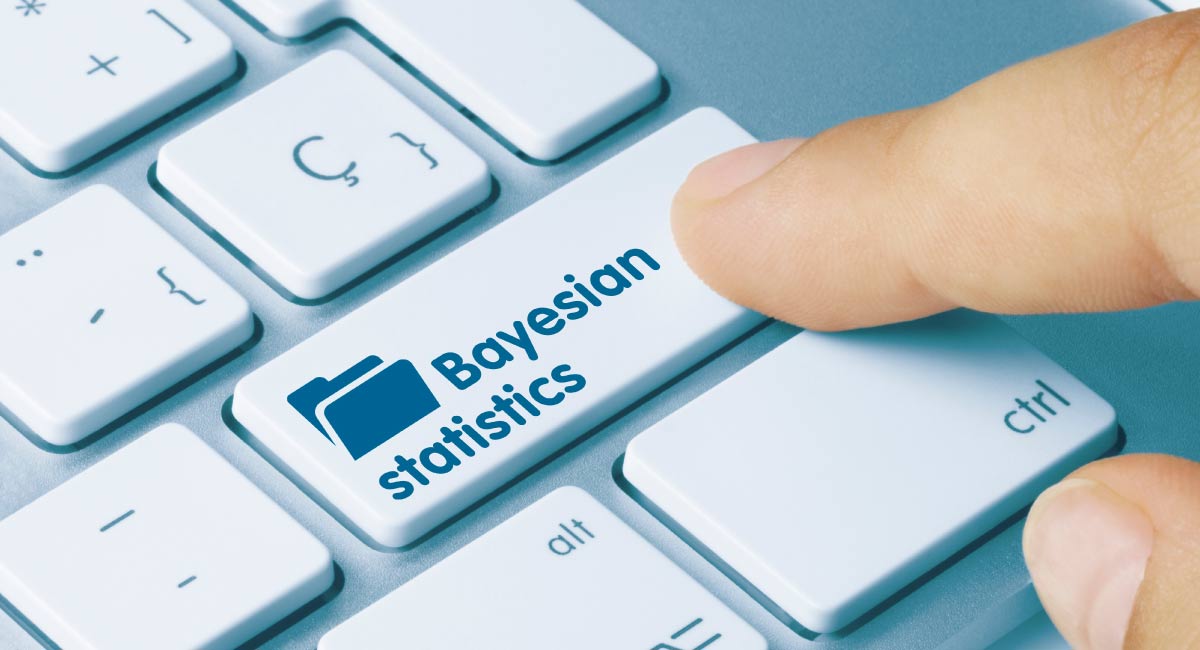We humans are creatures of belief. Our beliefs guide us, shape our perceptions, and dictate many actions. However, people who value personal growth and learning will modify their beliefs by acquiring new information. Fields like artificial intelligence and machine learning embrace this kind of growth, and that’s what we’re here for today.
This article explores Bayesian statistics, including its definition, fundamentals, usage, pros and cons, and how a data science bootcamp can help you learn how to use statistical tools (and others) to bolster your career skill set.
So, what are Bayesian statistics?
What is Bayesian Statistics?
Put simply, Bayesian statistics is a data analysis approach based on Bayes’ theorem. According to this theorem, available knowledge regarding parameters in statistical models is updated using the information gathered from observed data. So, Bayesian statistics gives us the mathematical tools to update our beliefs regarding random events by incorporating new evidence or data about said events.
The Bayes theorem is a mathematical formula that determines the conditional probability of any given event. Conditional probability is defined as the chance a given event will happen based on previous knowledge of the occurrences of prior outcomes.
Bayesian statistics is used today in statistical analysis to make data-based decisions, deal with uncertainty and probability, and draw inferences from analyses.
Also Read: Technology at Work: Data Science in Finance
Digging into Bayesian Statistical Fundamentals
Let’s break down Bayesian statistics into its fundamental components.
- Conditional probability is the probability of an event (A), given (B), which is essential for updating beliefs. For instance, a medical researcher may want to explore the conditional probability of someone developing cancer, given a specific risk factor, like smoking. We can carry this into Bayesian statistics and update our beliefs using Bayes’ rule, working alongside the three essential elements in any given Bayesian analysis: prior distribution, likelihood, and posterior distribution.
- Prior distribution is a reasonable belief about the plausibility of an unknown parameter’s values of interest without any evidence from the new data we are analyzing.
- Likelihood covers the different possible values of the parameter based on new data analysis.
- Posterior distribution combines prior distribution and the likelihood using Bayes’ rule:
P(A|B) = [P(B|A). P(A)]/P(B)
In this rule, P(A) and P(B) represent the probabilities of the events A and B.
P(A|B) represents the probability of event A happening, given B.
P(B|A) represents the probability of event B happening, given A.
This process of updating prior beliefs using Bayes’ rule is known as Bayesian updating. The information we are trying to update can be called the prior. Note that the prior can take other data forms. For example, a prior could be a statistical estimate from a previous analysis or an estimate based on domain knowledge or belief. A prior belief doesn’t have to be quantifiable as a probability and, in some cases, could be subjective or qualitative. For instance, the prior belief could be our researcher mentioned above’s opinion on whether a patient had a specific form of cancer before any diagnostic tests could be conducted. The resulting information is the posterior after using the Bayes’ rule to update the prior. Thus, posterior distributions form the basis of statistical inferences made with a Bayesian analysis.
So, how does Bayesian statistics differ from frequentist statistics? And what is a frequentist statistic, anyway?
Bayesian vs. Frequentist Statistics
Frequentist statistics, also called classical statistics, assumes that probabilities are the frequency of particular random events happening in a long series of repeated trials. The primary difference between these two methodologies hinges on how they deal with uncertainty. For example, a Frequentist relies on long-term frequencies and assumes that probabilities are fixed and objective. On the other hand, Bayesians embrace subjectivity and the belief that probabilities change depending on additional new information.
Let’s look at the example of rolling a fair, balanced, six-sided die. If you roll that die 500 times, you may encounter a situation where you roll four sixes in a row. However, throughout those 500 rolls, you will get a six result once out of every six times. Thus, a Frequentist would conclude that a die roller has a one in six probability of obtaining a six result on their next roll.
Bayesians see it differently. For example, consider the probability of rolling greater than a four on that six-sided die. Two numbers (five and six) are greater than four and six possibilities. So, you divide two by six and get 0.33333, and that’s your probability of rolling greater than a four on the die.
Also Read: Five Outstanding Data Visualization Examples for Marketing
Should You Use Bayesian or Frequentist Statistics in A/B Testing?
A/B testing, alternately referred to as split testing, compares two or more different versions of something to determine which works better. A/B testing in a digital format, like for a website or a marketing e-mail campaign, tries to identify which version performs better in creating a desired outcome, such as clicks, signups, or engagement.
In the frequentist approach to A/B testing, tests begin by assuming that there is no difference between the two variations. The goal is to determine whether the results are meaningful enough to disprove that initial assumption.
However, with the Bayesian statistical methodology, prior knowledge forms the initial hypothesis, and the beliefs are adjusted and updated as new data surfaces. Unlike the frequentist approach, which establishes strict boundaries on whether something’s 100% true or false, the Bayesian approach gives probabilities of whether the hypothesis is true or false. For example, there could be a 75 percent chance the hypothesis is true and a 25 percent chance it’s false.
So, the best methodology for conducting your next A/B test should depend on the sample size, context, and whether or not you’re incorporating beliefs or prior knowledge into your process.
How to Use Bayesian Methodology When Conducting an A/B Test
You don’t have to be a data scientist to effectively use Bayesian methodology in running an A/B test. Follow these simple steps:
Form your hypothesis
Suppose you hypothesize that a more accessible sign-up form will encourage more people to sign up for free product trials. You believe reducing the form’s required fields will make things easier, minimize friction, and streamline the process, resulting in greater participation.
Determine the probability that the hypothesis is true
You’ve had good results using shorter lead capture forms for similar campaigns, such as product demo requests. Based on that experience and information, you guess there’s a 70 percent chance of success if you condensed the new user sign-up form.
Collect the data and calculate posterior probabilities
Collect the data on sign-up rates as users interact with your new form. Update the hypothesis and assumptions as the new data rolls in. This updated value becomes your posterior probability.
Iterate, collect more data, repeat
Now, that new posterior probability becomes the prior probability for the next round of testing. For this example, sign-up rates increased by 25 percent with the new form, so this information becomes the new prior probability. Repeat the cycle, refining and optimizing as needed.
Also Read: Data Science Bootcamps vs. Traditional Degrees: Which Learning Path to Choose?
The Advantages vs. Disadvantages of Bayesian Statistics
Let’s briefly explore the pros and cons of Bayesian statistics.
Advantages of Bayesian Statistics
- It handles multiple tests well. Since testing isn’t forced into a true/false proposition, Bayesian statistics is well-suited for multiple testing situations.
- It offers incorporation of previous information and continuous updating. Bayesian statistics shines in situations where there’s a lot of prior data. This information boosts the statistical power to find relevant associations and make studies more efficient. The current posterior can be used as the prior knowledge element in future studies.
- It’s an intuitive interpretation. The Bayesian process is remarkably similar to how humans process information in their minds, making it more intuitive to use.
- It generalizes classical analysis. Classical statistical inference assumes no prior knowledge. Bayesian statistics helps narrow down what could be an infinite number (due to no prior information) based on prior knowledge.
Disadvantages of Bayesian Statistics
- Defining prior distributions can be challenging. Implementing prior information isn’t straightforward, and experts may find it difficult to translate the knowledge into statistical terms.
- It poses greater technical complexity. Many calculations that power Bayesian analysis require integral computations and operations with distributions. Skills in Bayesian programming are also helpful.
- It can be computationally intense. Computing complex integrals and using iterative methods for estimation can slow down the process and unduly absorb a significant amount of computer processing.
- There’s a strong potential for subjectivity. Although Bayesian statistics is typically more intuitive and results are easier to interpret, probabilistic outputs are arguably more subjective, leading to different interpretations and decision-making choices. Everyone assesses risks and probabilities differently so that other actions might be taken based on the same result.
Also Read: Data Scientist vs. Machine Learning Engineer
How to Increase Your Data Science Proficiency
Bayesian statistics is part of data science, an exciting field that figures prominently in many of today’s hot technologies, such as artificial intelligence and machine learning. If you want to learn more about data science and how to turn it into a career asset, consider an online data science program. This 44-week bootcamp covers descriptive and inferential statistics, exploratory data analysis, model building and fine-tuning, large language models (LLM), generative AI, and more.
Glassdoor.com reports that data scientists earn an average salary of $112,874. Check out this course if you want to immerse yourself in the world of data science and make it a career path.
You might also like to read:
What is Natural Language Generation in Data Science, and Why Does It Matter?
What is Data Wrangling? Importance, Tools, and More
What is Spatial Data Science? Definition, Applications, Careers & More
Data Science and Marketing: Transforming Strategies and Enhancing Engagement
An Introduction to Natural Language Processing in Data Science






